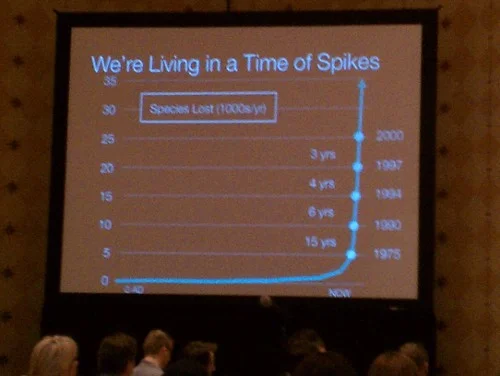This morning at SXSW, Andrew Zolli, curator of PopTech, talked to Hannah Jones, the VP of Sustainable Business at Nike about innovation, design, and sustainability through open data and collaboration.
The age of singularities
Raymond Kurzweil and other technology theorists have promoted the idea that the accelerating rate of technological change will so dramatically change society that forecasting is nearly impossible. Some believe we are in the time immediately preceding a technological singularity. Zolli says we are also almost certainly on the precipice of an ecological singularity.
"We're living in a time of spikes," said Zolli. "We didn't grow [human poplation] on an S-curve, or a J. We grew on an L." We'll be adding the next billion people to the population in only a decade. You can also see these spikes in various ecological variables. For example, the number of species lost also follows an accelerating L-curve:

Zolli drew further connections between exploding population, resources, and global temperature anomalies. "These forces have a dramatic and direct impact on life today," Zolli continued. And although everyone will be affected by these, not everyone is preparing well. That's where Jones came in--to talk about what Nike is doing through its Sustainable Business and Innovation team.
Nike recognized that these changes will have an impact on their customers and their business model. They've set their sights on how to lead and thrive in a sustainable economy. The team's mission is to help Nike figure out how to disconnect their products and business model from depleting resources. Their goal is that by 2050, Nike products will be completely decoupled from fossil fuels and all water used will be returned to the community.
The call for change at Nike
In 1992, there was hardly such a thing as "corporate responsibility." But that's when Nike found itself in the middle of an anti-globalization movement and at the center of attacks on child labor. Jones described this as "the best thing that ever happened to us," because it forced the company to change. It forced them to open up, learn to listen, and recognize that they would need help to change their system. They recognized that their system was fundamentally flawed, inelegant, wasteful, and vulnerable to big problems in the supply change.
The disruptive challenge
As one example of the ecological issues facing Nike and other companies, it takes 5,700 liters of water to get one t-shirt to a consumer. That's especially stunning at an event like SXSW, where there's someone thrusting a free t-shirt into your hands on every corner. "These t-shirts are being used with substantial amounts of water that could mean the difference for a community having access to food and clean water," said Jones. In the future, Nike (and anyone in the business of making t-shirts) has to rethink how they can share with and give back to those communities they're taking away from.
About five years ago, Nike created "stress indicators"--things like what would happen with unemployment, or if the price of cotton rose. Their big question form these is how fast they can scale change, and how collaboration and new forms of innovation can make that happen.
How the open source model can help
"Based on the success of open source within narrowly defined traditional IT conversations, it's now being adopted by the sustainability community," said Zolli. Global Pulse at the UN is taking all the aggregate data and indices of baseline temperature readings on those stressors and making them available as open data. In one example, he showed Water for People, which allows for real-time efficacy reports for water, now in 60,000 communities. The ability to look at the mashup of data between the UN and how water is being used is increasing effectiveness of wells and other local resources and facilities.
Collaboration with the competition
Jones said that in her industry, there once was a belief you should never reveal the location of your factories. The result was that brands that worked in the same factory or same area weren't collaborating on the working conditions in those factories and communities. Nike chose to release their factory data, which led others to follow suit, now allowing competing companies to work together to improve conditions.
Nike also has released IP data for many of their products, particularly ecologically-related successes, in hopes that someone else can use that work to improve the world for everyone. Through GreenXchange, others are enabled to do the same. Its patent licensing tool lets people and organizations get the rights to patents that help them innovate, and through Creative Commons licenses, the patent owners get credit for their work and, in some cases, licensing payments.
Change your culture
"We're pretty lucky," Jones said. "Our culture has a tendency towards irreverency and risk-taking, and a delight in innovation." Nike's corporate culture rewards collaboration and the freedom to experiment, all because of the crises they faced for not being transparent, for not collaborating. "The collaboration story is when you mash up different communities, you get the answers."






Comments are closed.